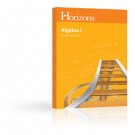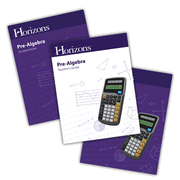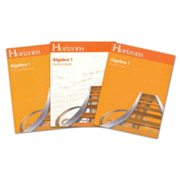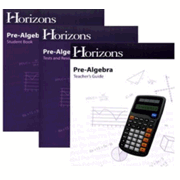Horizons Pre-Algebra is included among my TopPicks. Horizons Algebra 1 is so similar to Pre-Algebra that I decided to combine their reviews into one. However, Algebra I didn't make my Top Picks because it is a little more challenging to use than Pre-Algebra.
Both courses use a traditional approach that also includes some use of manipulatives—more in Pre-Algebra than in Algebra 1. Each course has three components: a teacher’s guide, a student worktext, and a Tests and Resources book. These are sold as a boxed set.
Lessons follow a commonly-used format: presentation of a new concept, guided practice (titled “classwork” in the student text), then independent practice. Teacher’s guides have teaching tips that highlight points the teacher might explain. Many times, the presentation of a new concept is explained well enough in the student text, that no teaching is required. Occasionally, concepts and skills are taught only from the teacher’s guide. Among them is the use of algebra tiles in both courses. In Pre-Algebra, among other topics taught only from the teacher’s guide are those on the use of a compass and protractor to draw a circle graph, the use of fraction-decimal flashcards, and the use of a scientific calculator.
Lesson presentation of new concepts is relatively brief. Rarely does the introduction within the student text walk the student through practice in problem solving. The guided practice or classwork is intended for that purpose. It is expected that a teacher will be working with students at this point. In Pre-Algebra, many students will be able to work through the new concept presentation and classwork on their own. Algebra 1, on the other hand, seems like it requires more teaching and assistance to work through classwork before students will be able to work independently. This means the parent or teacher needs to be familiar with the material before the lesson.
The teacher’s guides are useful. They list concepts, objectives, and materials needed, along with the teaching tips. Designed for classroom situations, they mention such things as students working on the board or students explaining problems for the class. Nevertheless, these courses can work well for homeschoolers. Ideally, a parent working with a single child will use the teaching tips to teach the lesson with concrete examples and explanations. These courses will probably work best for most homeschoolers using a combination of some lessons being taught and others completed independently, depending upon the content and teaching tips. Pre-Algebra is more likely to work for independent study than Algebra 1.
A "Readiness Evaluation” and answer key is in the front of the teacher’s guide. Sixteen tests and four exams are included in the Tests and Resources book for each course. The teacher’s guides have reduced pictures of student text pages and quiz and test pages with answers overprinted, so they serve as your answer keys. Eighty additional work sheets are in the Test and Resources book for each course, and some of these may also function as quizzes.
The student worktexts are very attractively printed in full-color. The number of activities and problems to solve does not appear overwhelming compared to some texts that are dense with problems. However, some of Horizon’s problems will take some time to complete. For example, one problem on p. 170 in Pre-Algebra instructs the student to “Find the mean, median, mode, and range. Then draw a histogram and a box-and-whisker plot. Football scores one Saturday were 14, 0, 7, 26, 13, 27, 36, 37, 24, 7, 7, 31, 20, 19, 24, 27, 17, 10, 31, 24, 24, 27, 41, 34, 16, 13.” Frequent word problems help student to understand practical applications for what they are learning. So there is plenty of work without pages appearing cluttered with problems.
Every tenth lesson in Pre-Algebra includes an interview with a Christian who uses pre-algebra skills in his or her career. In Algebra 1, every tenth lesson focuses on a sport, hobby, or activity such as soccer, fundraising, and amusement parks. Word problems in that lesson and some subsequent lessons are then based on the interview or the theme. Also in every tenth lesson, students are given a set of questions in multiple-choice, standardized test format to help with test preparation skills.
For both courses, students will need to have a scientific calculator, colored pencils, and graph paper. (Three pages of graph paper are included at the back of the Pre-Algebra student text.)
Note that Alpha Omega identifies Pre-Algebra as a seventh grade course and Algebra 1 as an eighth grade course. They could also be used for grades eight and nine respectively.
Pre-Algebra
This is a challenging course. While it reviews the basics of addition, subtraction, multiplication, division, and number theory, it quickly moves into signed numbers, exponents, factoring, square roots, and order of operations. It continues through work with fractions, decimals, and percents including much practical application. A good deal of attention is given to graphs, probability, and statistics. Geometry covers perimeter, area, and volume as well as topics like congruent triangles, and nets of solid figures (two-dimensional representations of three-dimensional objects as if they were opened up and laid flat), lines, angles, graphing points on a coordinate plane, and slope-intercept form. It even introduces trigonometry. Algebra concepts taught in this course are performing addition, subtraction, multiplication, and division of polynomials, including factoring. Other topics such as the metric system and measurement are taught.
The teacher’s guide is useful. It lists concepts, objectives, and materials needed, but most useful are the teaching tips. Designed for a classroom situation, it mentions such things as students working on the board or students explaining problems for the class. Nevertheless, this course will work well for homeschoolers. Ideally, a parent working with a single child will use the teaching tips to teach the lesson with more concrete examples and explanations as well as the extra topics mentioned above.
In addition to the items mentioned previously as required for both courses, students will need a protractor, a straight edge, and one dice. Other items such as blocks, scissors, tape, a party hat, and coins are used rarely and are open to makeshift substitutes.
While other simple manipulatives are used from time to time, the most important manipulatives for concept development are the algebra tiles. These are printed in full color in the Tests and Resources book and need to be cut out. I recommend that you laminate these for easier handling. The algebra tiles teach algebra concepts using the “rectangle-building” method, similar to what is taught in Math-U-See. Personally, I very much like to use this visual representation for algebra to help students really grasp what is happening when they manipulate equations.
This book also has “formula strips” that are to be given to students for use in some lessons. These restate some basic formulas such as that for finding the area of a circle or measurement equivalents such as 1 mile = 5,280 feet and metric-English equivalents. There are 24 of these strips to be used with different lessons, and formulas are sometimes repeated on more than one strip. The reason for presenting formulas this way rather than in the textbook is that the strips are sometimes used with quizzes and exams where it would not be appropriate for the student to have access to the text. Of course, students need to memorize some formulas. The teacher’s guide indicates which formulas are not given on the ACT/SAT tests (and therefore not on the formula strips) and must be memorized.
Fraction-Decimal Flashcards are used in a number of lessons, but these must be purchased separately. Some students will not need to use them and can skip them. Their use is directed from the teacher's guide, so students will not notice they are missing if they are working independently.
The text is clearly written for a Christian audience with many references to church, pastors, a gospel magic show, designing shirts for a youth retreat, missionaries, and other church-related activities.
Algebra 1

Like Pre-Algebra, Algebra 1 begins with review of foundational topics such as absolute value, exponents, roots, radicals, order of operations, factoring, and prime numbers. It moves on through standard first-year algebra topics including various strategies for solving equations, graphing linear equations, solving and graphing linear inequalities, working with systems of equations, quadratic equations, rational expressions, and radicals. It covers mixture and motion problems, ratios, and rates. It also introduces functions relatively early in the course and teaches discriminants toward the end.
This course is probably more challenging to use than others popular among homeschoolers because in most cases, the parent or teacher will need to help students work through the beginning of each lesson to learn new concepts. This seems more demanding than in Pre-Algebra, probably because the concepts taught are more challenging.
Plenty of word problems help students understand how some of the concepts and skills they are learning might be applied in real life. Most word problems are based on each unit’s theme (e.g., football, soccer, fundraising, Winter Olympics) which might work well if students are interested in the theme but might be a hindrance if not.
While algebra tiles are included in the Tests and Resources book, students are told that their usage is optional the few times they are portrayed within lessons. Thus, they play a much less significant role than in the Pre-Algebra course.
Unlike in the Pre-Algebra text, I found no Christian content in Algebra 1.











